How might we help children invent for social good?
What surviving an attack from a man-eating tiger has taught me about invention and rural entrepreneurship
I stayed in a tribal village in India for a year teaching children leadership skills through design thinking. Here’s a story behind my non-profit initiative and how we’ve impacted 1200+ children from 3 rural areas (also a short segway in which I was chased by a man-eating tiger)
Can children invent for social good?
We expect kids to do kids-related work, but what if they stepped up as leaders and gave back to their community? This was the guiding question behind this social initiative.
As an impact initiative, we followed the open innovation framework for structuring our work. Systemic change does indeed take time. 1-2-3 or even 5-10 years to have something tangible. Most of the social innovations got stuck at prototype/scaling stage which we wanted to avoid.

I stayed with the locals in the tribal village of Maharashtra, India to understand the context. To bond with the villagers, I actively involved as a teacher, helped with the jaggery production and rice harvesting. The day ended with copious notes from all the observations.

Lobhi village was quite remote and secluded. Lying amidst a thick forest belt often frequented by leopards and tigers. This is a picture that I took while being chased by one of these man-eating tigers which visited our village during summertime (yes, I live to tell this story)
While working with rural children closely, I was baffled by their creativity. Less was more!
They build upon innovative ideas using fewer resources. They played with flowers, fruits, clay and even dried leaves. The play didn’t require plastic toys or some fancy 3D printers

Yet, at the same time, their creativity was underutilized. 70 percent of India’s workforce resided in rural areas but only 20% of the graduates were workforce ready. The ethnography studies led to the formulation of our social initiative.

2+ years of experimentation in the form of pilots in rural schools helped us to carve out this program. We aimed at providing leadership skills through design thinking. The program was divided into three phases (unconditioning, critical thinking & design thinking)

Why design? Because design is not just about making cute little drawings, but so much more. You could think about problems critically and solve them. We believed in the vision of nurturing such young changemakers through design.
As a product of the traditional educational system, you had to do a lot of ‘unlearning’ to look at problems differently and to tackle them. The first phase of our program did exactly that. Letting your mind unlearn, and to let your creativity juices to flow more freely.

We also observed a lot of students getting stuck with creative block to build and explore. So we designed various challenges to create an enriched visual library of mechanisms, structures, materials and applied science/maths for the kids
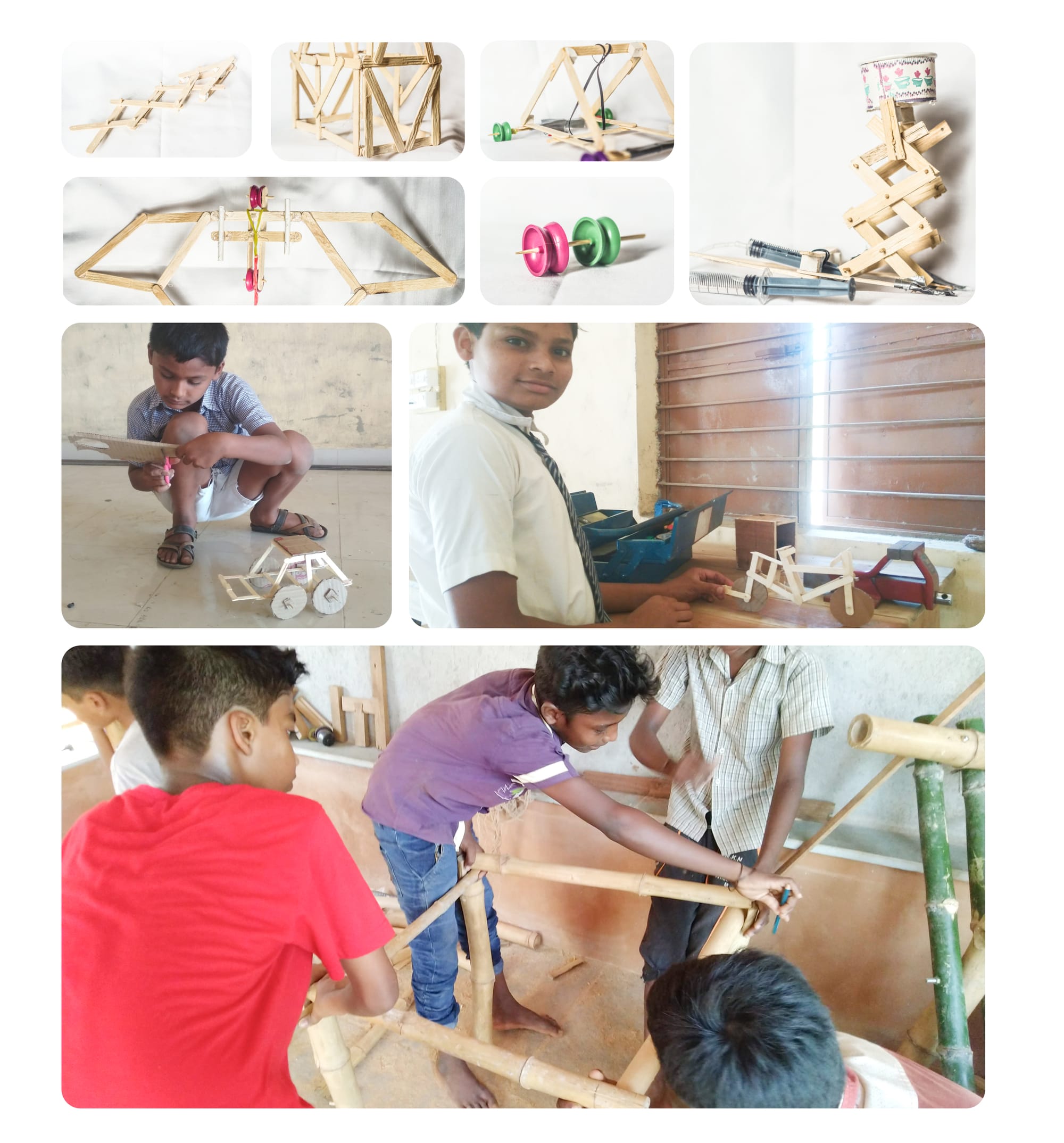
This is one such example from an activity which we designed. The challenge was to build a bridge that could hold their own weight using popsicle sticks
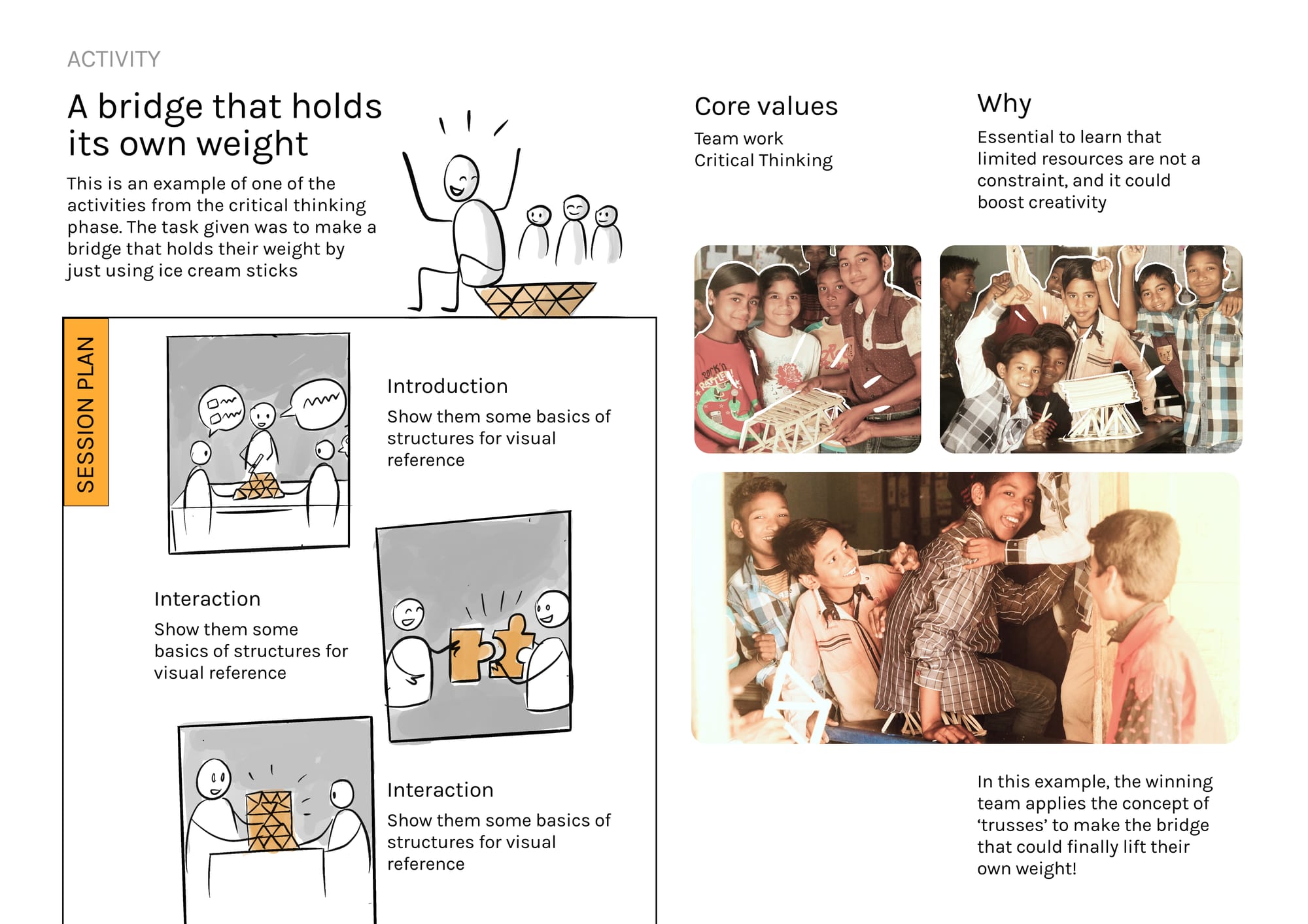
This is another such example from the design thinking phase. The students were asked to go for nature walks and document their observations. In this manner, the core values of observation, empathy and team work were reinforced among our children.

The vision was focused towards building self-reliant student leaders from the community. The OECD Learning Framework 2030 was followed to make sure that the knowledge, skills and values were aligned through our curriculum.

The tap (money) shouldn’t run dry, even if it is for a good cause. So we systematically injected funds through external grant agencies and crowdfunding support. The financial capital was leveraged along with social capital (media, mentors, hackathons) to scale impact.
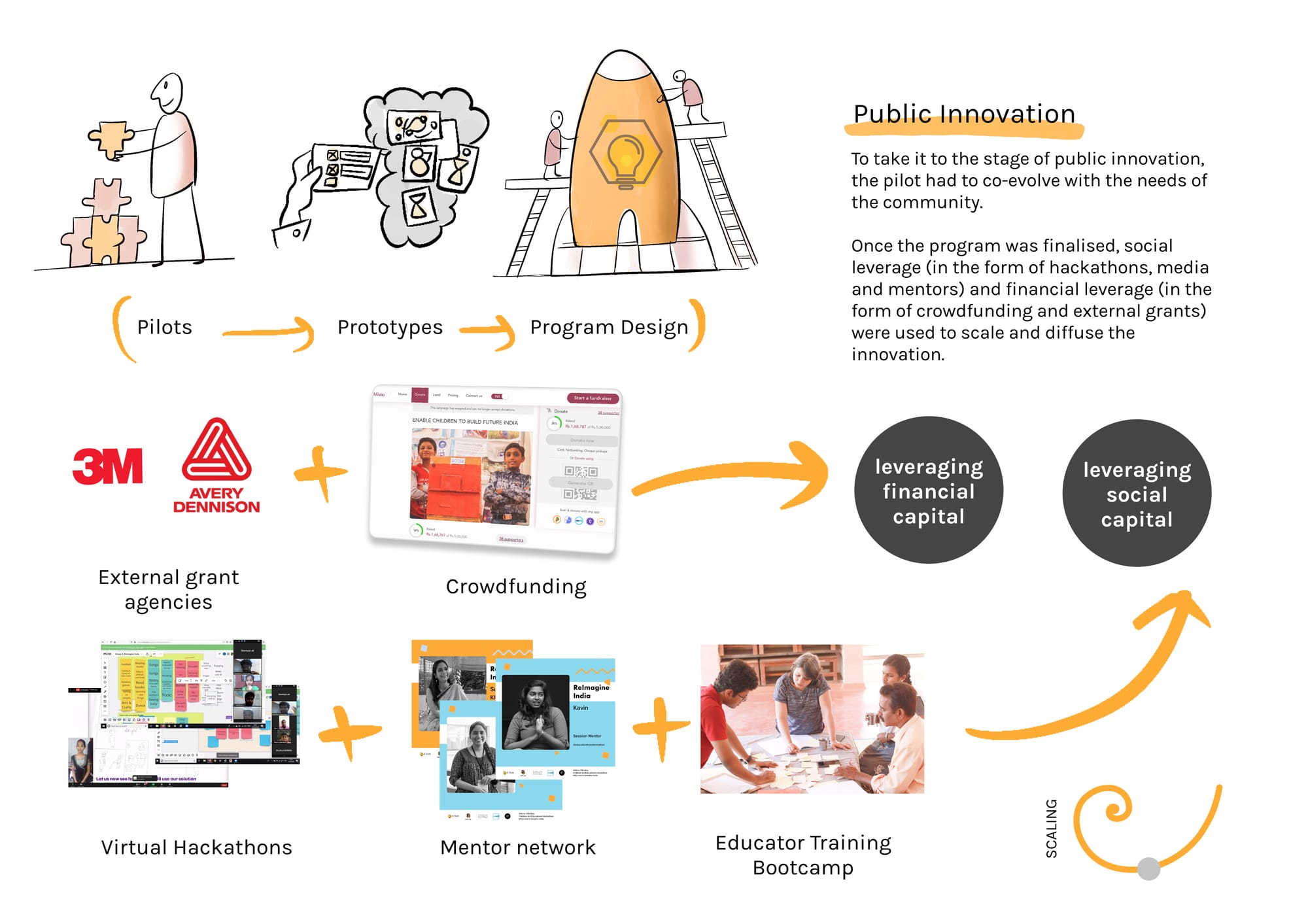
Will take you through some examples which I personally consider as a ‘systemic change’ for the communities.
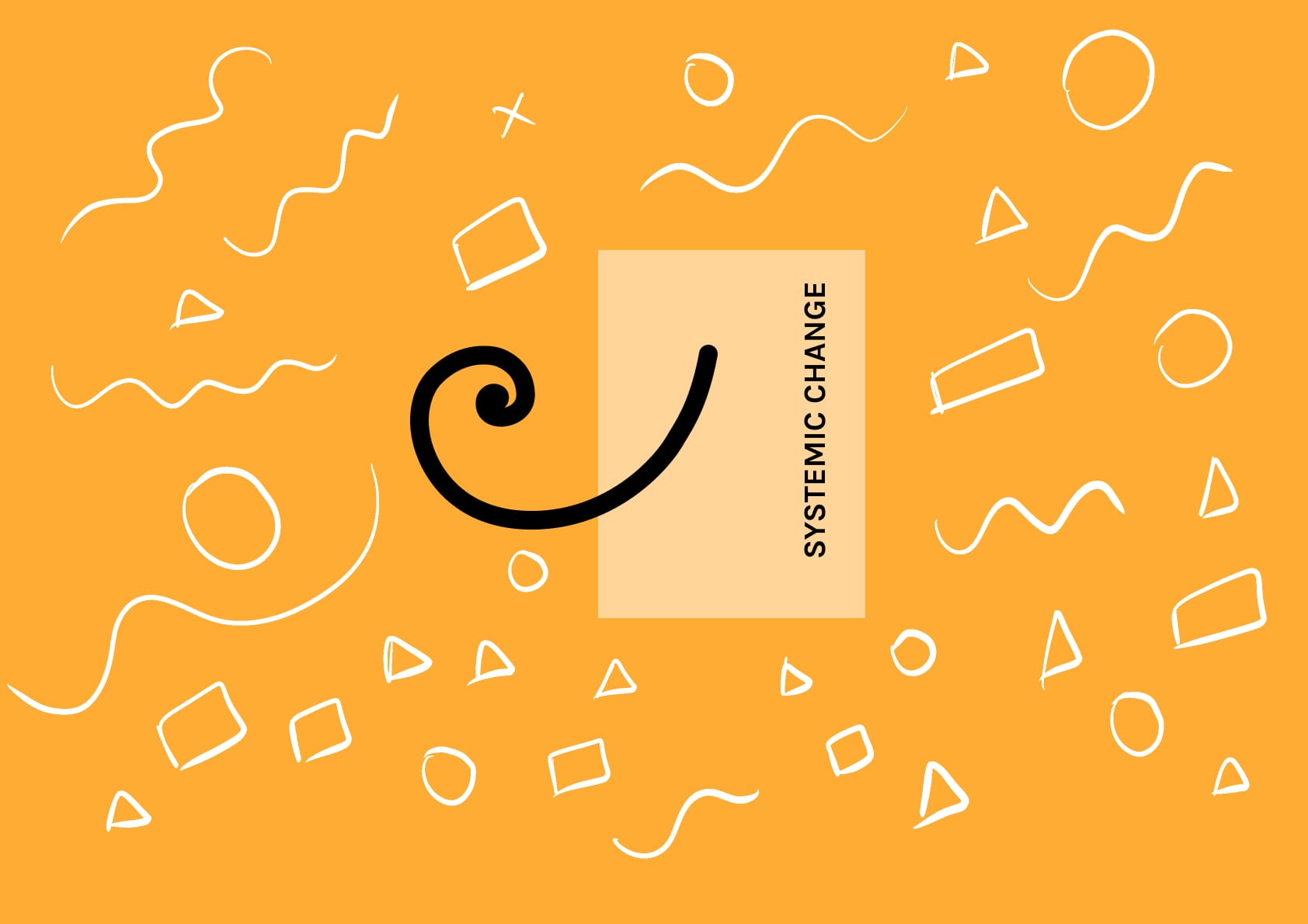
Our students build 12+ innovations over the course of time. The beauty of these innovations were the simplicity and resourcefulness and the ‘jugaad’ (frugal mindset). Local solutions developed locally by the locals
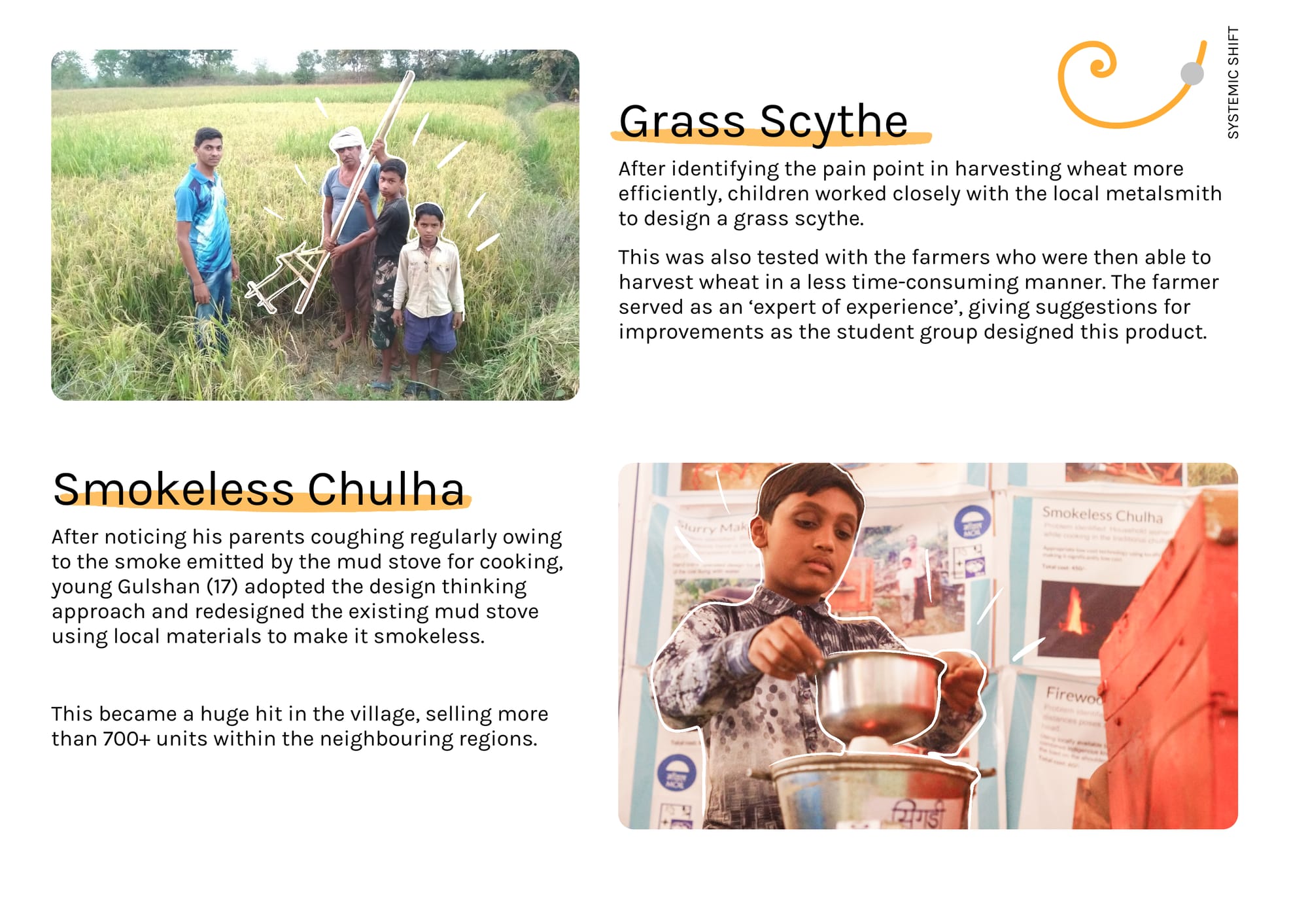
Among the innovations included a pole climber (risk free climbing of poles by electricians), smokeless chulha (smoke-free mud stove), grass scythe (for wheat harvesting), leaf plate machine (local production of sustainable leaf based plates) etc
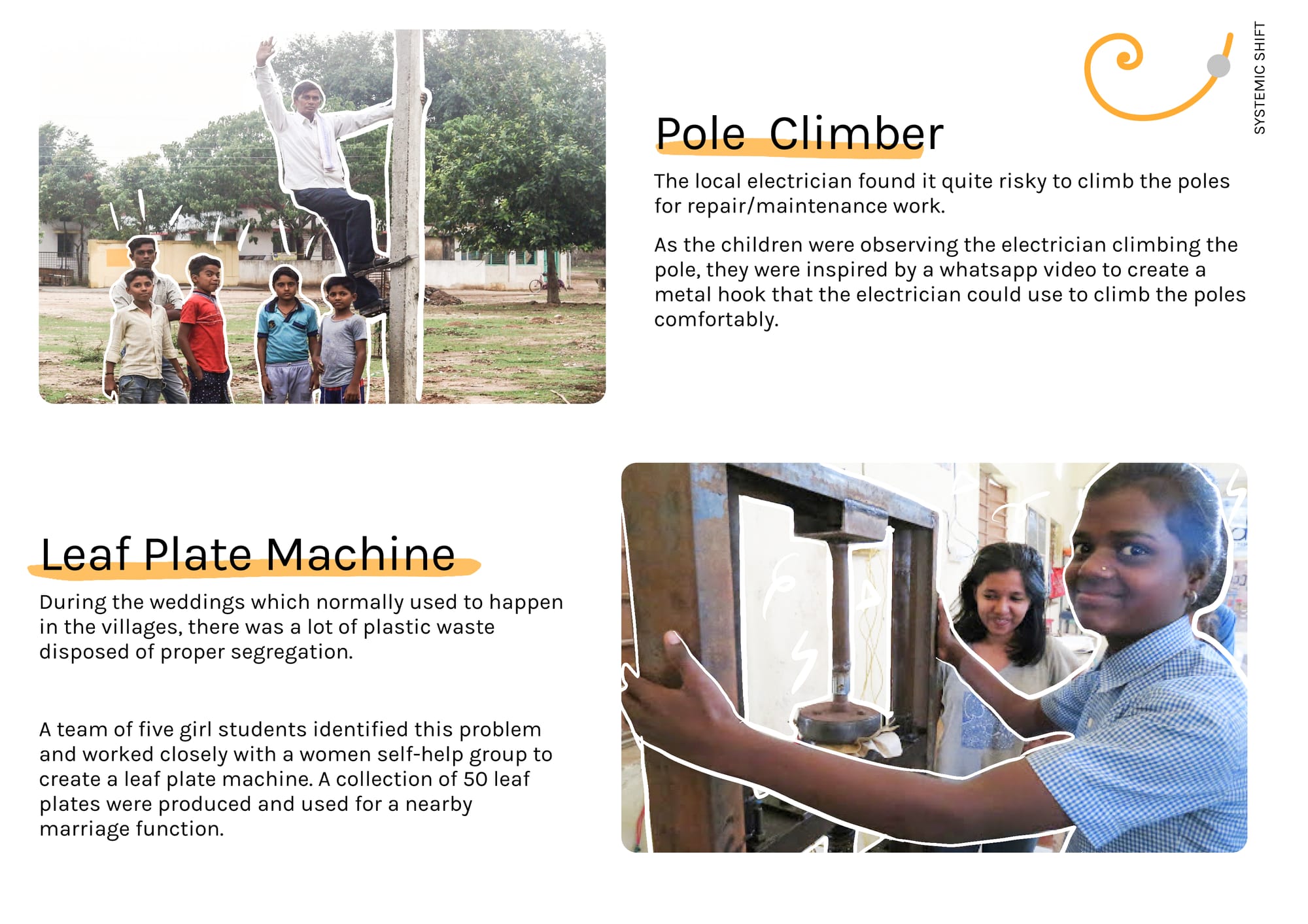
Firewood carrier: Helping farmers transport firewood through a bamboo based carrier. Slurry Maker: Clog-free slurry for biogas plants intended for cooking. The kids went through the design thinking process and developed these innovations
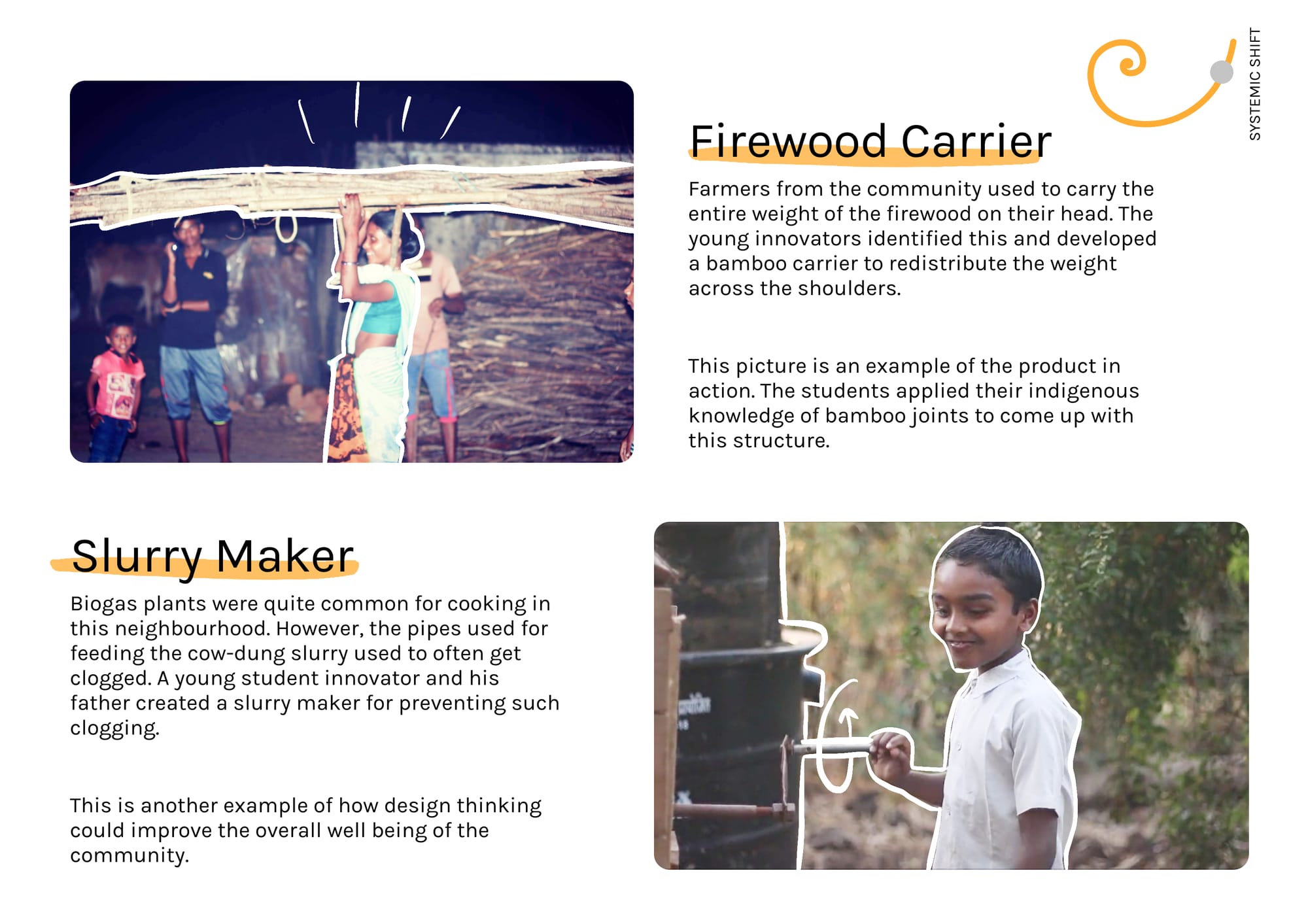
After seven months of lobbying, a one-of-a-kind children-led makerspace was established!
This provided the students with a platform for expressing their creativity. The students also actively involved with the community (farmers, artisans etc) and co-created solutions with them
A couple of our student innovators also got scholarships and were award recipients for their impact work. All these observations were published as a book titled ‘Rural Design Toolkit’. This was meant to encourage all our young grassroots innovators :)
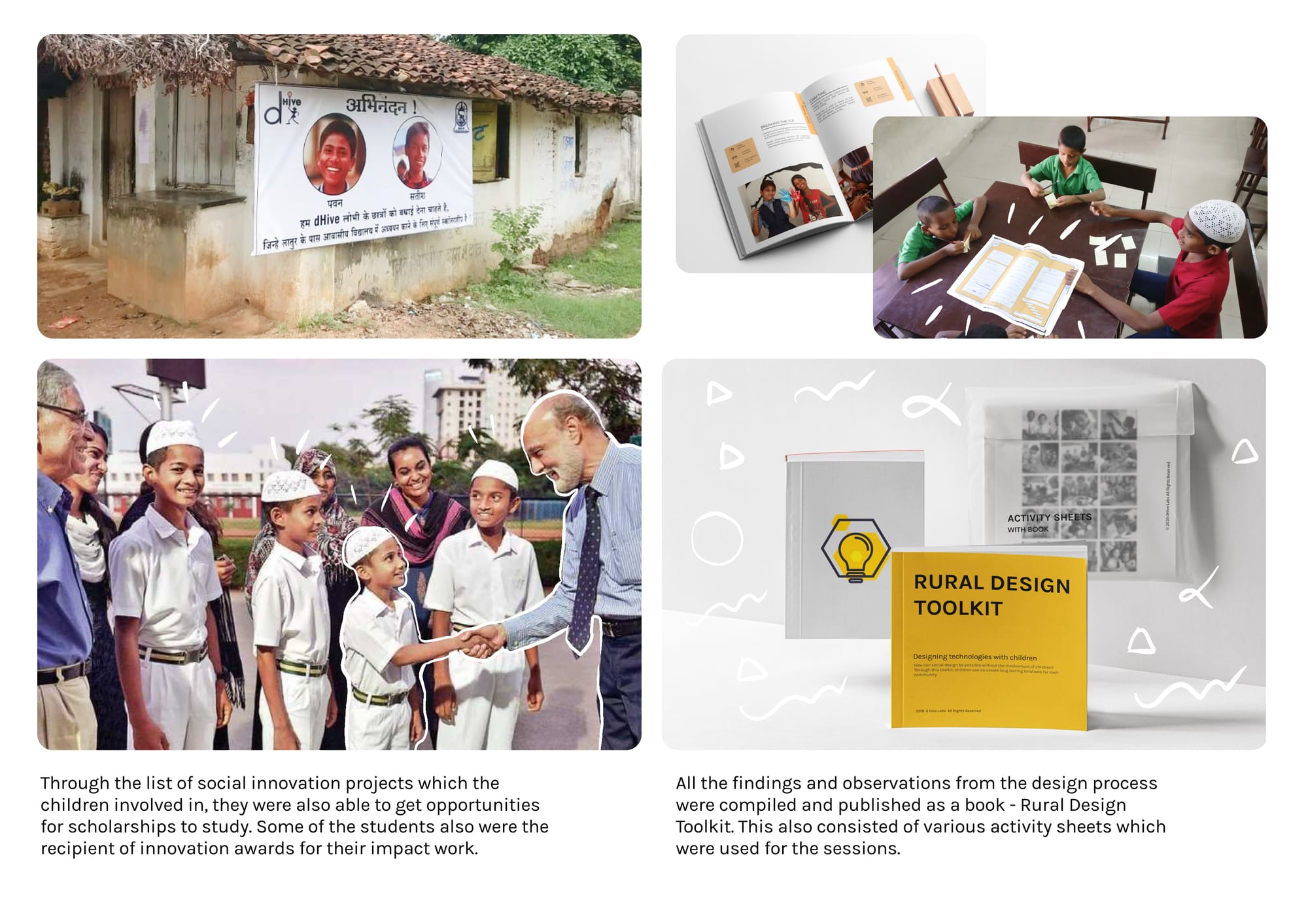
One of the innovations (smokeless chulha) also achieved significant maturity for taking it forward in terms of production. A group of 8 women members formed a team and were trained by the student innovator to take it forward as a social enterprise.

The systemic shift is still quite a hefty word. More than the innovations and the enterprises formed, the mindset shift which we observed is what we are the proudest of. From ‘What can the government do for us?’ to ‘What can we do for the community?’
Pluginisation of Modern Software
Keep the software simple, silly.
Transitioning from Adobe to Figma was a big change for me in my design journey.
At that time, the whole design ecosystem was revolving around Adobe. For image manipulation, you had Photoshop, Illustrator for vector graphics, Indesign for reports, XD for website/app prototypes and so on.
When Figma first started it was competing to disrupt this ecosystem for UI/UX Design. As the adobe ecosystem was offline-first, it turned out to be an expensive design choice. The USP of Figma was centeted around how everyone everywhere could design all at the same time without any latency.
This disruption is widely understood how Figma capitalised on this undue advantage. But one another aspect which gets missed in this whole David versus Goliath battle is ‘pluginisation’.
Opening Photoshop was like being given keys to a space shuttle control panel. You had all the buttons , functions and affordances at your door step. Imagine wanting to ride a cycle and being handed over a Lamborghini. The experience was heavily over engineered for first time users. It violated the (KISS — Keep it Simple Silly) Principle for them.
Compared to the space shuttle, Figma is a bicycle intended for people who wanted to ride a bicycle. However, if the cyclist wanted to upgrade the bicycle, let’s say add extra gears, slope assist, or even a nitro boost, that was possible. It’s a typical textbook case of what we can call as “IKEA effect”
The IKEA effect, named after everyone’s favorite Swedish furniture giant, describes how people tend to value an object more if they make (or assemble) it themselves. More broadly, the IKEA effect speaks to how we tend to like things more if we’ve expended effort to create them.
Everything can be modified and tinkered with. Making users feel more endowed with the software they interact with.
We’re already seeing this in action —- Pluginisation of Modern Software.
Obsidian is already in hot pursuit of this idea. They are encouraging a developer friendly ecosystem of plugins by extending support. Not everyone would be okay with the design choices exercised in a software. The best bet would then be to provide enough resources to the user so that they could customise it on their own.
You have software that can be configured as how ever you want.
Let's make every work 'strategic'
Thinking 10,000 ft above sea level.
A 'strategic' wrapper can turn a $100 work into a $10,000 work.
Thinking 10,000 ft. above sea level pays more. It’s a win-win for both sides.
If we take a look at the field of writing, the standard rates in this profession, as well as what writers do, usually the rates border around:
- Writing content: $200 / article
- Style guide: $2,000
- Content strategy: $20,000
Drafting a content strategy is a high-leverage activity as that strategy can be incorporated into any subsequent product. You do it once, the company uses it twice, thrice, or more.
Every project exists in multiple overlapping contexts - here’s some of the types of context to look for:
- People (who are the stakeholders? what do they care about?)
- Resources (what can they realistically do with your work?)
- Brand (what is the position of the company?)
- Marketing (audiences, channels, analytics)
- Business model (revenue, profit)
- Product (how does their product work, what is possible?)
- The user (who is the user? What do they care about?)
Tom Critchlow, a freelance consultant talks about his experience involving the leadership team from the very beginning of his assignment. He talks about how this helped him gather crucial context while pitching his work.
I was working as a marketing advisor for a client and early in the engagement (partly because we were discussing me becoming the full-time CMO) I was invited to sit in on their quarterly board meeting. This experience was formative in better understanding the drivers and motivations of the business - by understanding who literally owned the business better. This context was crucial for proposing work and for ensuring that pitching that work to the board was smooth.
Providing strategic work makes the work more valuable. The more valuable the work is, the more pricey it becomes.
Let’s imagine you’re a writer - commissioned to write for a client’s branded content site. Let’s say you get paid $200 per article. The work: writing.
From Writing to Strategic Writing
Here’s a list of context that one should ask for and where it’s not available or it’s done poorly offer to step in:
Creating a style guide for all the writers Competitive analysis for other branded content sites, who writes for them and how they operate A content marketing plan for the branded content site A content marketing plan across the whole brand Themed content franchises that can scale beyond individual posts SEO research into keywords they care about targeting
From Designing to Strategic Designing
How might we think of designing-in-context?
You’re being commissioned to design a landing page for the client’s brand. Let’s say you get paid $1000 for the landing page.
- Creating a brand identity, brand DNA for the company
- Competitive analysis of other branded websites. What is their overall design approach and how they communicate?
- Understanding user behavior and goals. This helps enhance the effectiveness of the landing page as we know who we’re targeting.
- Incorporating conversion optimization techniques: As the landing page is designed for conversion, strategic design here involves working closely with marketing teams to understand campaign objectives.
Work is highly valuable when the work is delivered in-context. Strategic design is exactly that. 10 years ago, We never had the job profile of a ‘strategic designer’. Fast forward now, and we have a whole gamut of design-related job roles ranging from strategic designers to business designers. Design is now both a noun and a verb.
From writing to designing, or any work in general, the path to strategic work looks something like this:
- Ask questions and be curious (about the business, the industry, the people)
- Explicitly ask to see surrounding context (e.g. as a writer, ask for the content strategy, as a marketer ask for the strategic roadmap)
- Then, next time explicitly ask to be included in the creation of the surrounding context
- Then, start offering and leading the projects to add the surrounding context
- Repeat as you expand your context
Being strategic is a mindset. A new way of navigating and understanding the work and it’s surrounding context. A $100 work with a ‘strategic’ wrapper can turn into a $10,000 work.
When I said, any work, I literally mean any work. Let’s take the business of Twitter Ghostwriters. Businessesmen in Hong Kong and the Middle East pay up to $25 an hour for someone to talk to them in English, helping them improve their skills. Yes, even Twitter thread creators. Nobody has time, everybody wants attention. In this context, the ‘strategic wrapper’ could possibly include a social media strategy and calendaring. In this case, it becomes a $10,000 work as execution is easy. You can easily outsource it. Hard thinking is hard.
So, next time you’re getting into a project with a client — get strategic!
Making Nielsen’s heuristics more digestible
A new spin to an ancient usability heuristic.
Jakob Nielsen’s heuristics are probably the most-used usability heuristics for the design of interfaces.
If you go to their website, you might encounter these dry prescriptive statements as shown in the image.

Recently came across this blog by Michael Prestonise and loved the way he had repurposed the old wine in a new bottle.
It converted a boring user manual into an engaging flashcard format through great questions. Some of these questions for reference—
Does the interface provide visibility of the system status throughout the task to keep the user informed about what is happening?
Will the user need to learn any new terms in order to understand this interface and complete the task?
Does the interface provide an “emergency exit” if the user makes a mistake at key points in the task?
Does the interface use consistent language throughout the whole task?
What error conditions might the user accidentally find themselves in as they try to complete the task?
Will the user need to remember anything from earlier steps as they complete the task?
Does the interface provide any affordance(s) for experienced users to complete tasks more efficiently?
Does the interface display extra information that is not relevant to this step in the task?
Does the interface provide a clear explanation of the error and how it might be resolved?
If the user gets stuck or is unable to complete the task, can they find any documentation or help?
It can take time to learn new ways to think about your designs and build them into your design process. You will benefit from these heuristics even if you add them one at a time. Additionally, these heuristics aren’t just for designers. Product managers, engineers, operational team members, sales, marketing, etc. can all apply these heuristics to interfaces (whether they are in your product or somewhere else, like your marketing website). You can share these with your team and evaluate your user interfaces together — Michael Prestonise
Startups are interesting even if most startups fail.
I’ve found Patrick Collinson’s argument to be the most convincing:
“Part of the reason startups resonate with people is because the outcome is not guaranteed. If it were guaranteed, it would be boring… Whether or not you’re the best person in the world at what you do, you’re probably not going to alter Google’s trajectory. But if you really want to benchmark yourself and see how much of a contribution and impact you can make–which is a really compelling prospect for a lot of the best people–a startup is a much better place to test that.”
Pinterest founder Ben Silbermann emphasized this as well:
“No smart person that you’re hiring is under the illusion that you have a crystal ball into the future and that joining is a guaranteed thing. In fact, if you’re telling them that and they select in, you shouldn’t hire them because they didn’t pass a basic intelligence test. I think it’s important to tell them what’s exciting and where you think the company can go. But also tell them where it will be hard and chart your best plan. And then tell them why their role can be instrumental–because it will be… What I would discourage doing is whitewashing all of that. If people are joining your company because they want all of the certainty and safety of working at Google but also the perks of working at a small startup with lots of responsibility and transparency, that’s a really negative sign.”
Apparently in the early days of PayPal, Peter Thiel and Max Levchin would tell people after they interviewed all the reasons that the company would fail: “Visa and MasterCard want to kill us. We also might be doing something that’s illegal. But if we succeed, we’ll redefine payments.”
Don’t whitewash the risks. Instead tell them how your startup will change the world if you succeed and how their role will be instrumental in affecting that change.
Startups are a fertile ground for learning through risk-taking. Peter Levels executed one of the best diversifying strategies to be more robust in such a risk taking environment (check out the full video here):
Insights are not just a salad of facts
What is an insight? Really?
What is an insight?
An insight for Elon was: “The most entertaining outcome was the most likely’. His tweet suggests that he believes in taking risks and embracing the unknown, rather than playing it safe.
For Maya Angelou, the renowned poet and civil rights activist, it was: “People will forget what you said, but people will never forget how you made them feel”. A perspective on the impact of emotional connections. ^6ce4d2
Some of these insights challenge norms and encourage a re-evaluation on how we look at the world.
Getting insights however is not so easy.
We cannot just pluck insights from a tree and serve it on a platter.
As Chris Kocek states in his book, The Practical Pocket Guide to Account Planning, “Contrary to popular belief, there is not a mythical tree inside our offices from which we pluck insights on a daily basis.”
For individuals like Elon and Maya Angelou, it likely required a wealth of life experiences spanning years to distill such profound wisdom into concise statements.
Insights play a pivotal role in shaping the direction of a project, product, or even an entire company. Their significant return on investment is why companies prioritize investing in insights. While it’s impossible to replicate the depth of insights derived from decades of lived experiences, alternative approaches through design research methods can lead to valuable insights.
Let’s understand the shape of an insight by how the design research methodology ships insights. A typical design research cycle looks like this:
You’ve got a problem or a question that needs solving. It could be creating something new or making an existing thing better.
First, you gather clues. You talk to people who might know something about the problem or have experienced it themselves. You listen to their stories, ask them questions, and take notes.
Next, you look for patterns. You analyze all the information you’ve collected and start seeing common themes or trends.
It’s like connecting the dots in a big picture. This helps you uncover insights and understand what really matters to the people involved.
Eventually, this becomes a process to churn out insights on a consistent basis within an organisation. There is a navigation from data, information, knowledge, INSIGHT and finally, wisdom.
An insight is not just a statement. On the contrary, it is everything else but the statement. It’s the reasoning behind that statement. Insights are stories conveyed in a succinct way to help us with sensemaking.
Why do they help us with sensemaking? Why can’t all the data captured through all the interviews and literature studies be enough?
Picture this: 111111111111111….(million digits)
You’re brain finds it easy to store it (even if it’s around a million digits). You’ve been able to find the pattern here. A repetition of the number one. A million times.
But now, imagine this: 100010…(million digits)
You’re not able to make a head or tail of this information. You are not able to find patterns anywhere and are stuck.
Eventually you slice and dice the data, segment and start seeing some patterns emerging from what seemed like a random salad of 1s and 0s.
This is the process which design research adopts. Except that instead of 1s and 0s, you are trying to slice and dice transcriptions, anecdotes, statements, reports .
Insights help compress data in a beautiful way as you can clearly see the ‘why’ behind them. It ultimately has the shape of a story.
Your brain is a sprawling library of information. Stories, however, are the VIP section—easily accessible and constantly on your mind. And stories are wired into our very essence. We’re storytelling chimpanzees.
They captivate us, stick in our memory, and stand the test of time because they tap into the core of what it means to be human—our emotions, experiences, and the universal themes that connect us all.
Insights are arrows that cut through all the noise. They’re not just a salad of facts.
Minimum Lovable Product
And not Minimum Viable Product.
We might have to rethink on the definition of the ‘Minimum Viable Prototype’.
Especially since the bar for what’s viable keeps rising up, with the likes of Gumroad, etc being built in a weekend.
Notion, Figma, Airtable, Superhuman and Discord with their extremly high quality user experience has led to a highly devoted user base among tech Twitter. It would be foolish to think of the MVP of Notion as a bare bones note taking app. The high quality UX has been extremely critical to its success.
We had low-floor, low-ceiling setups for an MVP in the past. Now, the ballpark has shifted quite drastically. It’s a higher floor, and an even higher ceiling.
Today, there’s so much capital in the startup ecosystem, and so many tools that make it cheap and easy to ship a product, that baseline applications have become a commodity. Most users can intuitively feel the cheapness of the average product today, and their app fatigue is at an all-time high.
MVP stands for Minimum Viable Product, and I want to specifically emphasize the word “viable.” We’re continually experiencing quality inflation as app-building frameworks get better. As it gets easier to build basic applications, the floor for what is actually viable rises.
The problem today is that most founders’ idea of what constitutes a software product’s MVP is outdated.
One of my best examples of the ethos of a ‘Minimum Lovable Product’ is the development of mymind by Tobias:
We don’t want to stress about keeping up with other tools (many of them here today, gone tomorrow) and shipping new features to satisfy “users” who demand it. We don’t want to try to meet every need and create a monster of a product, dinging bells and tooting whistles until we spontaneously combust. We want to achieve the purest form of our tool and let it continue to be that. We want to be here 10 years from now. We want to create, if possible, the digital equivalent to the iconic chair, sunglasses or notebook. Something you proudly care for, polish, return to, count on year after year. Something you own for a long, long time.
The desperation for newness is a sickness of technology.
It’s a disease perpetuated by algorithms, desire for immediate satisfaction and the craving of dopamine unfulfilled by unhealthy lifestyles.
Refusing to succumb to that illness requires saying no. As creators and business owners, it requires forgoing the temporary rush of users riding one tool to the next. It requires coming back to our original mission, over and over again, every time we make a decision about our tool.
And we hope it leads to something meaningful. A tool built to last.
Minimum lovable product is also not to be engulfed in featuritis and leading to doing all about everything. It’s about a balance where you see the whole triad as a whole. Making something lovable is about shifting the mindset. It’s not about how it works, but the way it works. 1
Take an example of keyboard shortcuts, which causes a lot of love among early adopters. Another thing is doing a little bit extra pixie dust. For example, in the way Obsidian has made plug-in development more lovable.
Design methods are life jackets. Not straight jackets.
Structures, whether they’re processes, frameworks, or plans, are excellent tools to navigate complicated problems. They bring efficiency, reduce ambiguity, and offer defaults.
However, when dealing with fundamentally complex problems, applying structure too early can lock in outdated notions. Because structures tend to ossify. As more team members join after the structure is in place, they may not understand the underlying thinking. They start adopting processes and frameworks while being unable to answer why they exist.
Templates are ready-made blueprints. They’re convenient, no doubt. But they often end up replacing the hard work of thinking about the problem.
In the worst cases, templates are square pegs forced into round holes. And they can sometimes lead to what I like to call “performative solutions.”
You’re doing the steps because they’re there, but are they really solving for the actual job-to-be-done?
Here’s a guiding principle to help you think about processes:
Process should formalize how things already work. It should fit the problem naturally, not impose itself.
Misapplied structure can actively obscure the underlying dynamics of a problem. This hinders real understanding, as people must now overcome the inertia of the structure to discover how things truly work!
You see, people will tell you not to reinvent wheels.
I disagree.
There’s no substitute for thinking about a problem bottom-up. And if you find there’s no need to think about the problem bottom-up, you’re— either not working on the right problem, — or, underestimating the complexity of the problem.
Making something from scratch lets you see all the little details and nuances that templates might miss. And the process of figuring things out on your helps you build real courage and conviction in your solutions.
This also ties into the adverse effects of gyaan-culture.
The journey from complexity to simplicity is often a hard-fought one. Experienced practitioners arrive at simplicity after having waded through complexity. It’s only after having their hands dirty all this while that they are able to distill their wisdom into clean insight.
However, their audience misinterprets this templated simplicity as an all-encompassing prescription, leading to all sorts of trouble.
The simplicity presented is like the visible tip of an iceberg, while the underlying complexity remains hidden. This misunderstanding can and often does lead them to passively accept templates and avoid thinking independently.
So, think of any framework as a lens that guides thinking, not something that replaces it. No single lens is universally applicable, and overreliance on one will only create blindspots.